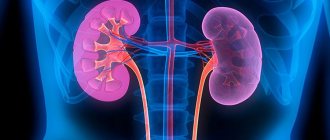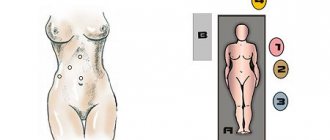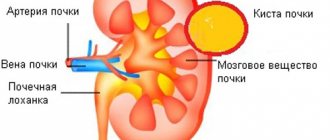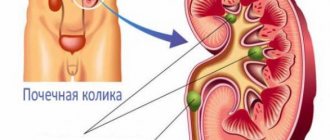A kidney cyst is a benign cavity with dense walls filled with liquid contents. It is located in any part of the organ, has a variety of sizes, is prone to enlargement and suppuration, and often recurs after a therapeutic puncture.
Our expert in this field:
Isaev Artur Ramazanovich
Oncologist, urologist, surgeon
Call the doctor
The only and absolutely radical way to treat cysts is surgery ; there is no effective drug therapy for cystic pathological changes.
Prevalence of kidney cysts
One of the most common urological pathologies, however, is more typical for older men. The main causes of the disease have not been determined; there is a high probability of initiation of cystic pathology after injury. Hereditary inferiority of the internal epithelial lining of the renal tubules cannot be ruled out, when with a slight increase in the pressure of produced urine, protrusions easily form in the wall, which over time increase and “detach” from the renal tubule.
Prices
| Name of service (price list incomplete) | Price, rub.) | In installments (RUB) |
| Consultation with a surgeon for surgery (ACTION) | 0 | — |
| Online doctor’s opinion on surgery (SPECIAL) | 0 | — |
| Renal cyst puncture | 20000 | from 1999 |
| Kidney resection I category. difficulties | 72000 | from 7195 |
| Kidney resection II category. difficulties | 126000 | from 12591 |
| Kidney resection III category. difficulties | 180000 | from 17988 |
| Laparoscopic retroperitoscopic excision of a kidney cyst, category I. difficulties | 80000 | from 7995 |
| Laparoscopic retroperitoscopic excision of a kidney cyst, category II. difficulties | 130000 | from 12991 |
* You can read more about the conditions here - Treatment on credit or in installments.
Main mistakes in diagnostics
In rare cases, renal cell carcinoma may be disguised as a cyst, forming a decay cavity disproportionately larger than the tumor itself.
Mistaking polycystic degeneration caused by genetic abnormalities for a large simple kidney cyst. Polycystic kidney disease and kidney cysts are treated differently.
Undetected genetic mutations leading to polycystic disease, when severe congenital pathology is interpreted as a banal cystic cavity.
The specific nature of the cystic cavity has not been established - a parasitic or infectious disease.
Refusal of high-tech imaging methods - CT and MRI in favor of ultrasound alone.
The most important role in diagnostics is given to the quality and resolution of the equipment, but everything is useless if the knowledge and experience of the specialist is insufficient; in our clinic we guarantee a balance of technical capabilities and professionalism
Prevention
To reduce the risk of developing kidney cysts, you must adhere to a number of rules:
- promptly treat infections and inflammations of the genitourinary system;
- avoid hypothermia, kidney injuries;
- come regularly for preventive examinations;
- stick to a low-salt diet.
Medical doctors remind: the earlier a kidney cyst is detected, the risk of complications is no less. You can make an appointment with a doctor around the clock. Patients are accepted seven days a week.
What complications are possible if you refuse surgical treatment?
Find out how to get rid of kidney cyst pain!
- Chronic pain in the lumbar region on the side of the pathology.
- Increased blood pressure when the vascular bundle is compressed by an enlarging cyst.
- Constant or frequent presence of blood in the urine.
- Impaired renal function due to replacement and compression of the organ parenchyma resulting in renal failure.
- The formation of stones due to chronic stagnation of urine in the pelvis when the outflow of the ureter is blocked by a cystic formation.
All of the above conditions can be independent and accompany the ongoing process of cyst enlargement; differential diagnosis will be made possible by timely surgery.
Only surgical treatment will get rid of the cyst and direct the treatment of concomitant diseases towards an adequate modern approach.
We have already saved 1289 kidneys
Take care of yourself, make an appointment with a urologist now.
Services and diseases
Symptoms Treatment of kidney cysts. Laparoscopic operations for kidney cysts . A kidney cyst is a spherical cavity filled with fluid. A kidney cyst is a benign process (unlike a tumor), that is, in 70% of cases it can be monitored without resorting to active surgery. If the kidney cyst is less than 4-5 cm in diameter and does not cause disturbances in the kidney’s blood circulation and urine outflow, then dynamic monitoring using ultrasound is required. Carrying out therapeutic measures for a kidney cyst is advisable in the presence of clinical manifestations (pain in the lumbar region, increased blood pressure), in case of impaired outflow of urine from the kidney or in case of impaired circulation in the affected organ due to the presence of a cyst, or in the case of a complicated course of the disease (suppuration, hemorrhage) .
Symptoms Treatment of kidney cysts. Laparoscopic operations for kidney cysts . A kidney cyst is a spherical cavity filled with fluid. A kidney cyst is a benign process (unlike a tumor), that is, in 70% of cases it can be monitored without resorting to active surgery. If the kidney cyst is less than 4-5 cm in diameter and does not cause disturbances in the kidney’s blood circulation and urine outflow, then dynamic monitoring using ultrasound is required. Carrying out therapeutic measures for a kidney cyst is advisable in the presence of clinical manifestations (pain in the lumbar region, increased blood pressure), in case of impaired outflow of urine from the kidney or in case of impaired circulation in the affected organ due to the presence of a cyst, or in the case of a complicated course of the disease (suppuration, hemorrhage) .
A parapelvic cyst is a cyst located in the region of the renal sinus, the hilum of the kidney. The clinical manifestations of a parapelvic cyst are determined by its location, that is, pressure on the pelvis and vascular pedicle of the kidney. Patients experience pain. Hematuria and arterial hypertension may occur. Diagnosis is the same as for solitary renal cysts. The need for treatment arises when the cyst increases significantly in size and complications develop. Technical difficulties in its excision are associated with the proximity of the pelvis and renal vessels.
Treatment Indications for surgical treatment are the size of the cyst more than 3 cm and the presence of its complications. The simplest method is percutaneous puncture of the cyst under ultrasound guidance with aspiration of its contents, which are subject to cytological examination. Unfortunately, with this method of treatment there is a very high probability of developing a relapse of the disease. In addition, technically, not all cysts can be punctured (depending on its location in the kidney). Currently, the main treatment method is laparoscopic excision of the cyst . It is important that with laparoscopic access a radical operation is performed (excision of the cyst with histological examination), and at the same time the principle of minimally invasiveness is maintained (3 point marks remain on the abdominal wall). Laparoscopy can remove a kidney cyst of any size and location. The enlarged image on the monitor allows you to see the subtle anatomical structures of the kidney, which makes the operation delicate and safe. Discharge from the hospital – on 4-6 days. Working capacity is restored by 10-14 days after surgery. In the future, dynamic monitoring by a urologist and ultrasound are required - after 3 and 6 months. Open surgery - lumbotomy - is rarely used. It is indicated when the cyst reaches enormous sizes, is multifocal in nature with atrophy of the renal parenchyma, and also in the presence of its malignancy. In such cases, kidney resection or nephrectomy is performed.
Treatment of kidney cyst
The therapeutic approach is determined by the size of the formation and its condition - inflammation or suppuration.
If the diameter of the cyst is less than 3 cm and there are no objective signs of inflammatory changes, a therapeutic puncture is possible with the removal of fluid from the cavity and the subsequent introduction of a sclerosing substance into the capsule. The effect of manipulation is unpredictable, it is influenced by the rate of formation of cystic fluid and the lability of the cyst walls - dense tissues are less likely to stick together. In response to the introduction of a sclerosing agent, the epithelium lining the cyst can increase fluid production, nullifying all efforts.
The only radical treatment method is surgery with excision of the walls of the cystic formation.
The operation is performed open - in the traditional way with a dissection of the abdominal wall in the lumbar region and through several punctures - laparoscopically. There are differences in the duration of the operation; endoscopic intervention takes longer, but the recovery period after it is disproportionately shorter.
The specialists of our clinic guarantee a 100% result of the operation with the complete exclusion of cyst recurrence. The patient is given the right to choose the method of operation, we have high surgical quality
Consequences of a cyst on the kidney
Kidney cysts are not the most common disease. However, no one is safe from its appearance. At its core, it is a cavity inside or on the surface of any organ, filled with serous fluid. The consequences of a cyst on the kidney depend on its location, shape and size. To plan further treatment, it is necessary to undergo a diagnosis, establish the causes, determine the benignity or malignancy of the disease, and also present the general condition of the patient.
Causes of renal cyst
A cavity filled with fluid appears on the kidneys for various reasons: • Congenital factor, as a result of illnesses suffered by the mother during pregnancy;
• Inflammatory processes in the kidney tissue (nephritis of various etiologies); • Traumatic factor; • Work in hazardous industries; • Urolithiasis disease; • Tuberculosis; • Malfunctions of the immune system; • Endocrine diseases (hormonal imbalances); • Acute or chronic renal failure. Uncharacteristic symptoms of a neoplasm include pain in the lumbar region, difficulty urinating, change in urine color, and problems with blood pressure. For diagnosis, palpation and percussion methods are used, as well as blood and urine tests. Ultrasound and x-rays with contrast have proven themselves to be effective. A biopsy followed by histological examination of the resulting tissue sample will accurately determine the structure of the neoplasm.
Why is a kidney cyst dangerous?
In most cases, a parenchymal tissue cyst is a benign formation, found mainly in adults.
However, it has very serious consequences for the body: • Impaired urine outflow, which can lead to hematuria (severe intoxication of the body with products of protein metabolism); • The occurrence of renal failure; • Rupture of a cyst with its contents entering the abdominal cavity with the risk of developing peritonitis; • Inflammation of the neoplasm with suppuration and transformation of the cyst into an abscess; • Transition of a benign process into a malignant one.
If you have been diagnosed with this, do not self-medicate under any circumstances. You can start the disease and worsen your condition significantly. The cyst will not resolve on its own, so contact only qualified doctors.
Treatment methods
The Center for Modern Medical Technologies has all the conditions for effective treatment of renal cysts.
Our own diagnostic center, a certified laboratory, modern operating rooms, comfortable wards for inpatients - all this without queues and at very affordable prices. We practice treatment only according to the standards of evidence-based medicine: • Diet therapy; • Medical conservative treatment; • Puncture of the cyst with removal of fluid from the cavity; • Sclerosis; • Complete removal of the kidney or part of it. If cysts are present in both organs, the doctor tries to preserve at least one of them as much as possible, but the prognosis in such cases is unfavorable.
Make an appointment with a doctor at the urology department by phone to get answers to your remaining questions.
What complications develop when radical treatment is delayed?
- Rupture of the cystic cavity with the development of a clinical picture of an acute abdomen; in such a situation, surgical intervention is inevitable for health reasons;
- Suppuration of the contents after a common cold resulting in a carbuncle or kidney abscess and sepsis, which will require removal of the entire kidney and long-term treatment;
- Bleeding into the cystic cavity with the development of a picture of an acute disease and, possibly, surgical intervention for emergency indications;
- Functional kidney failure and the development of organ failure followed by hemodialysis.
Operation
There are two methods of surgical treatment of kidney cysts:
- puncture with removal of fluid from the formation followed by sclerotherapy (gluing the walls of the cyst to prevent relapse);
- complete removal of the cyst (both open and laparoscopic).
If it is not possible to puncture the cyst, then it must be removed.
In medicine, a laparoscopic method is used to remove a cyst, since the procedure is performed without large incisions, which speeds up recovery and minimizes the risk of complications. The duration of the recovery period depends on the type of surgery, the amount of work performed and the general condition of the patient.









